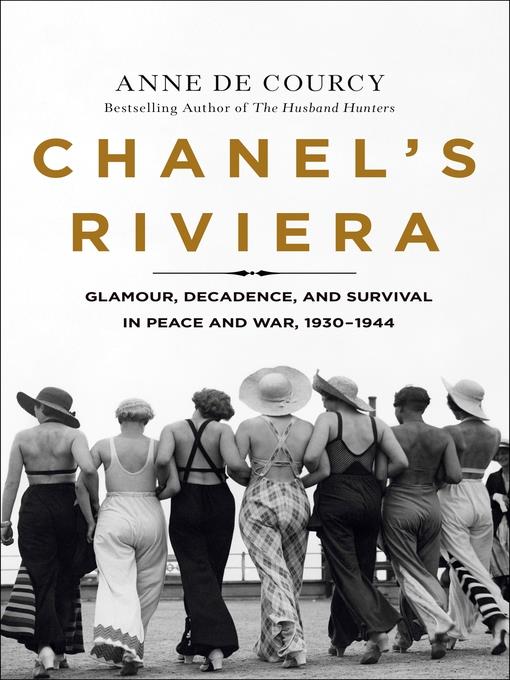
Chanel's Riviera
Glamour, Decadence, and Survival in Peace and War, 1930-1944
کتاب های مرتبط
- اطلاعات
- نقد و بررسی
- دیدگاه کاربران
نقد و بررسی

November 15, 2019
A gleaming social history of the French Riviera in the 1930s, "probably the heyday of the Riviera in its modern sense." In her latest, De Courcy (The Husband Hunters: American Heiresses Who Married Into the British Aristocracy, 2018, etc.) delivers portraits of a variety of wealthy social circles with the voyeurism of a who's-who society column. The author portrays American vacationers and European artists, writers, socialites, intellectuals, and public figures, including the Prince of Wales, Wallis Simpson, Jean Cocteau, and Winston Churchill. Coco Chanel--who, according to De Courcy, embodied "France's prestige"--is an alluring if elusive narrative hook. Accounts of her La Pausa home, her lovers, and her stays at the Ritz in Paris punctuate the text, from which she's often absent. The author gives much attention to extramarital affairs, entertaining affectations, and opiate addictions. Quotations from period diaries and letters enliven the narrative, though the overall effect is light and gossipy. De Courcy's discussion of Chanel's fashion rival, Elsa Schiaparelli, briefly brings the focus back to the titular character. At times, the author fetishizes the bygone glamour that characterized the landscape; Marlene Dietrich, for example, is deemed "the blonde to end all blondes." The rise of the Nazis serves mostly as historical background, and the author offers a reasonable consideration of Chanel's anti-Semitism. Later sections about English expatriates' struggles to flee, deportations, and collaborators in France revisit horrors and miraculous survivals, showing a clear rift between the rich--who experienced minor deprivations yet carried on much as before--and the people who were severely impacted. The unavoidable disjuncture between Chanel's privileged world and the one just outside it leads to a somewhat uneven narrative that will turn off many readers but appeal to those fascinated by the rich and famous. In its copious details, this lovingly researched portrait of paradise highlights the colorful glitz and too-familiar blindness of the ultrarich.
COPYRIGHT(2019) Kirkus Reviews, ALL RIGHTS RESERVED.

December 2, 2019
Journalist de Courcy (The Husband Hunters) portrays fashion designer Coco Chanel’s French Riviera milieu from 1930 through the end of WWII in this dishy and well-researched account. At a time when the Côte d’Azur had already become “the playground of the rich,” Chanel bought 12 acres above the village of Roquebrune and built a villa modeled after the convent where she’d spent her adolescence. Writers and artists including Colette, Aldous Huxley, and Pablo Picasso had homes in the region, and Winston Churchill, Vladimir Nabokov, and Chanel’s friend and lover Salvador Dalí visited during summers of “feverish gaiety, threaded through with rumor and suspicion” as the Nazi Party rose to power in Germany. After the fall of France in 1940, British nationals fled the Riviera, and de Courcy frequently and deservedly shifts the spotlight from Chanel to historical figures including Australian socialite Enid Furness, who helped Allied prisoners escape from a detention camp near the village of Èze. De Courcy describes the impact of anti-Jewish laws and food shortages on those who remained in the region, but lets Chanel off the hook for her anti-Semitism and her affair with Nazi intelligence officer Hans von Dincklage, who helped to insulate the designer from wartime deprivations. Nevertheless, this fluidly written history succeeds in capturing the era’s intoxicating mix of glitz and grit. Agent: Isobel Dixon, The Blake Friedmann Literary Agency.

January 10, 2020
De Courcy's (The Husband Hunters) social history considers Gabrielle "Coco" Chanel's spiritual home, the French Riviera, where the iconic fashion designer built her estate La Pausa. Close to Paris and her couture brand, this residence offered space for Chanel simply to enjoy life. In the 1930s, the Riviera was an elitist playground, but in 1936 France granted all workers annual vacation, which meant more people had time to visit the coast. When Germany invaded France in 1940, although the Riviera was in the "free zone," it was not exempt from privation. Having closed her business in 1938, Chanel wasn't terribly worried about the fate of France or anyone persecuted under the Nazis--instead, she desired "to go on living as she wished." In 1945, when the war ended, she reopened her business and resumed her lifestyle. The central character of this book is the Riviera, and how it weathered World War II, with Chanel serving as a spirited, bit player who embodies the characteristics of the era. VERDICT More a regional history scrutinizing the intersection of wealth and war through the biography of a famous resident than a traditional treatment of Chanel's life. Those seeking the latter may prefer Caroline Young's Living with Coco Chanel.--Jessica Bushore, Xenia, OH
Copyright 2020 Library Journal, LLC Used with permission.

November 15, 2019
This detailed social history uses copious name-dropping and gloriously gossipy text to highlight Coco Chanel's considerable influence on the south of France during the 1930s, providing insights into the decadent lifestyles and extravagant fashions favored by glamorous visitors to the Riveria. De Courcy (The Husband Hunters, 2018) is adept at describing displays of opulence, and proves equally capable when portraying the deprivations and reversals of fortune occasioned by the onset of WWII. Stories of bewildered internees, clueless socialites, heroes, cowards, victims, and survivors intermingle, and an epilogue provides post-war closure for many of the principal characters. And Coco? She shuttered her Paris couture business, but continued to live a lavish lifestyle, although her relationships with high-ranking Germans came under scrutiny. (She was taken in for questioning after the Allied victory, but apparently her international fame, plus her gift of a bottle of Chanel No. 5 perfume to every liberating American G.I., saved her.) This will be popular with royal watchers, fashionistas, and readers who relish the international social scene, and should cover new territory for most.(Reprinted with permission of Booklist, copyright 2019, American Library Association.)

























دیدگاه کاربران